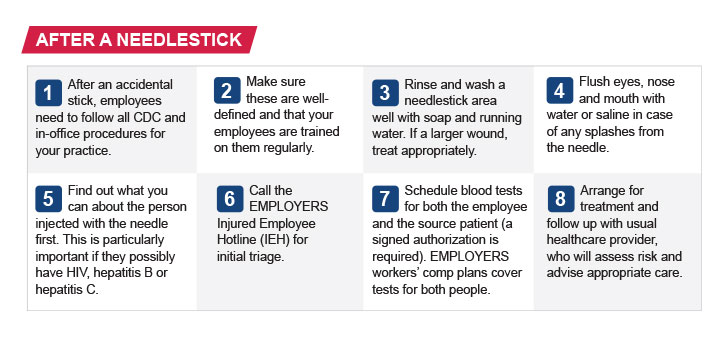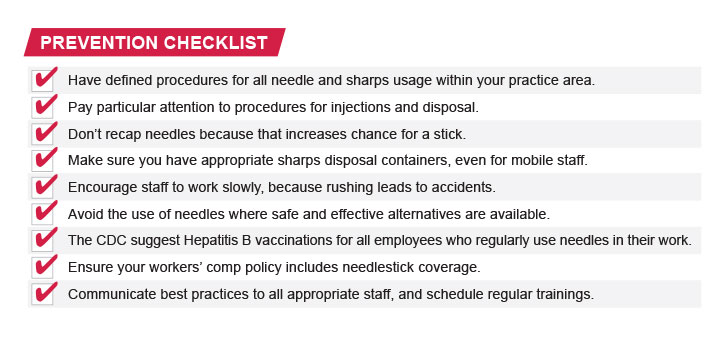Needlestick and other sharps injuries are a serious hazard in any healthcare setting. Incidental punctures by contaminated needles, broken glass and other sharps may expose healthcare workers to infectious fluids including bloodborne pathogens. With workers’ compensation insurance from EMPLOYERS, you’re covered. Learn what you can do to help prevent needlestick injuries in your medical practice and the most common needlestick injuries to watch out for, find how to prepare and protect your employees, and know what to do if a needlestick injury happens at work.
What to Do After a Needlestick Injury
You should always follow your internal office protocol and CDC guidelines for management of needlestick and sharps incidents. EMPLOYERS has created a step-by-step guide to help walk you through exactly what to do after a needlestick injury has taken place.

Reporting a Workers’ Compensation Needlestick Claim
Reporting a needlestick injury is as simple as calling the EMPLOYERS Injured Employee Hotline for help at (855) 365-6010. Our staff is available 24/7 and fluent in both English and Spanish, with accommodations for other languages.
Keep in mind not all workers’ compensation insurance provides the same benefits for sharps injuries. If your medical practice is insured with EMPLOYERS, our worker’s compensation coverage includes:
- Payment for the initial cost of testing your employee
- Reimbursement for the initial cost of testing the source patient – something other carriers may not provide
Call to Request Coverage for Workplace Injuries Now
The Most Common Causes of Needlestick Injuries
According to a nurses survey published by the US National Library of Medicine’s National Institutes of Health, the most common place needlestick injuries happen is crowded medical wards with syringe needles. But studies suggest only a fraction of needlestick and sharps injuries are even reported, with underreporting especially prevalent in operating rooms.
1,000 Per Day
The average number of sharps injuries for hospital-based healthcare workers nationally.
– Centers for Disease Control
Here are some of the most common causes of a needlestick injury to watch out for:
- Handling needles that must be taken apart or manipulated after use
- Disposing of needles attached to tubing
- Manipulating the needle in the client
- Recapping a needle
- Using needles or glass equipment to transfer body fluid between containers
- Failing to dispose of used needles in puncture-resistant sharps containers
- Lack of proper workstations for procedures using sharps
- Working quickly
- Bumping into a needle, a sharp, or another worker while either person is holding a sharp object
How to Prevent Needlestick and Sharps Injuries
Unfortunately needlesticks and sharps injuries do happen. You can use this quick checklist, which combines CDC Guidelines with EMPLOYERS procedures to help prevent these injuries and keep your practice safe:

For more information on needlestick injuries, protocols, safety and prevention, visit the additional resources included to the left. EMPLOYERS policyholders can also create custom safety materials by logging in to the Loss Control Connection℠.

